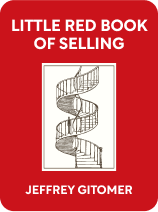

This article is an excerpt from the Shortform book guide to "Little Red Book of Selling" by Jeffrey Gitomer. Shortform has the world's best summaries and analyses of books you should be reading.
Like this article? Sign up for a free trial here .
What distinguishes a successful salesman from an average one? How do some salespeople manage to consistently close sale after sale, cashing in commissions, while others struggle to hit their minimum?
Many salespeople, especially at the beginning of their career, erroneously think that pushing the prospect to buy is the best way to clinch the deal. And while the aggressive approach might work from time to time, it’s not going to bring you consistent sales. Rather than pushing the customer to buy what you have, your job as a salesperson is capitalizing on the desire to buy—that is, making the customer want to buy your product.
In this article, we’ll discuss a few tips on how to do just that.
Understanding the Psychology of Selling
Many salesmen think that pushing prospects to buy their product is the way to go. But manipulation won’t get you very far in your sales career. To become successful at sales, you must learn how to capitalize on the desire to buy, and that requires an understanding of the reasons people buy.
You may think you already understand why people buy, but you don’t if you’re experiencing any of the following in your sales process:
- Customers object to your price.
- They request that you provide a bid or proposal.
- They won’t return your calls.
- They say they’re satisfied with their current vendor.
- You think sales are slow because the economy’s slow.
All of these experiences indicate you haven’t created an atmosphere conducive to buying by focusing on the reasons people buy. For example, if you’re wrangling over price, you’ve failed to convince the customer of your product’s value and fit for her, which are among the reasons people buy.
Here are the top reasons why people buy:
- They like the salesperson. Further, they trust, believe in, have confidence in, and feel comfortable with the sales rep. (The sales cycle starts with the customer liking and trusting the salesperson, proceeds to buying, and continues with an ongoing relationship.)
- They view the salesperson and company as different from competitors.
- They see the salesperson as a resource and as someone who’s trying to help them.
- They see value in the product or service they’re buying; they believe it will increase their productivity and profit.
- The product or service fits their needs.
- They view the price as fair for the value they’re getting, although it may not be the lowest available.
To find out specifically why your customers buy from you, ask them. The following sales tips will help you build on customers’ existing buying reasons to create an atmosphere conducive to buying.
Tip 1: Develop Your Brand
Potential customers “buy” the salesperson first, then buy what you’re selling. They buy your knowledge and expertise, the value you provide, your character, integrity, trustworthiness, and so on. To establish your knowledge and value and make them widely known, you need to develop a strong personal brand.
When you have a strong brand, customers are loyal to you, prospects call you, you get appointments with higher-ups more easily, and you get more “yeses” to meetings and sales than your competitors do. You attract sales success.
Personal branding isn’t difficult, although training classes often make it seem that way—it just takes hard work. Branding is increasing people’s awareness of you and your strengths. It encompasses putting your name on everything you do, with the goals of:
- Establishing yourself as an expert, resource, and innovator in your field
- Earning a positive reputation in the business community that accrues to your company and product
- Being seen as a leader in your field and the community
- Differentiating yourself from others in your field
- Creating demand indirectly for your product or service
Tip 2: Use Humor
Making people laugh relaxes them and creates an atmosphere conducive to buying. Laughing together is a form of agreement or approval, and agreement is a step toward selling. Besides helping you make the sale, humor builds customer relationships by facilitating friendship and respect.
To improve your humor, study humor, especially if you aren’t naturally funny. Here are some ways to learn to be funnier:
- Pay attention to what happens to you so you can reference funny events in jokes.
- Watch comedians on TV. Study their delivery and the audience’s reaction.
- Read joke books.
- Listen to children, who are naturally funny.
- Practice jokes with family and friends.
Safe topics to joke about include things kids say and do, traffic, and lines from television shows. In general, pick something that’s:
- Funny to you, so your joke is natural rather than forced.
- Personal: Poke fun at one of your personal qualities or features, but never make fun of others.
- Clean: Never make crude, ethnic, or gender jokes.
Tip 3: Be Creative
Along with humor, creativity will make you and your sales pitch stand out and be remembered. Here are four ways in which creativity can get a client’s attention:
1) At the start of a sales call, ask a smart, unexpected question instead of blathering on about your company and product. For example, ask: “How much does a lost hour of productivity cost your company?” or “How would you know whether you were overpaying for printing?”
2) Identify your customer contact points and change them so they’re distinctive—including the voicemails you leave, your cover letter, your phone greeting or voicemail message, your business cards, and so on. Fixing your voicemail message is the most important task because it can help you get new customers and act as word-of-mouth advertising (if you have a unique message, people tell others about it). Here are some ways to create a memorable message:
- Use a thought-provoking quote (change it daily)
- Record a message from one of your kids (“Hi, I’m Josh. Dad is out earning my college tuition…”)
- Make a joke. (“You’ve reached Tom at Premier Pest Control. Please tell us what’s bugging you…”)
- Record a testimonial from a customer. (“I’m Dave. I’ve been pain-free for five years, thanks to Wilson Chiropractic—I hope you’ll let them help you too.”)
3) Use creative follow-up methods to stay in front of the customer after a meeting—for instance, email a weekly tip, share useful information and testimonials, or send a newsletter.
4) Respond creatively to buyer objections. For example, when a prospect tells you she’s satisfied with her current supplier or product, you might respond: “Prospective clients often claim they’re satisfied with what they have—however, our customers tell us they’re thrilled with our product. Wouldn’t you rather be thrilled than just satisfied?”
How to Cultivate Creativity
You can develop creativity by studying and practicing it. Here are some ways to do this:
- Write down ideas: Creative ideas pop into your head quickly, then just as quickly vanish. So anytime you get an idea, write it down, and try to elaborate on it while it’s fresh.
- Find creative mentors who support and inspire your creativity.
- Read creative writers and books about how others have developed creativity.
- Be willing to risk failure: Failure is part of the creative process—it teaches you how to improve your ideas.
Tip 4: Ask the Right Questions
Most salespeople ask the wrong questions and therefore don’t get the answer they want (a “yes” to the sale). Usually, they’re questions aimed at getting the buyer to switch from a current supplier to your company. They encourage a focus on price rather than value. For example:
- How much are you currently paying for delivery? If I could save you some money, would you switch…?
- What would it take for me to earn your business?
In contrast, a successful salesman asks the right questions that help the buyer think about your product or service in terms of how it solves her problems or achieves her goals. They’re specific questions that uncover her frustrations, concerns, and needs, so you can show how your product will make her life easier—and she’ll conclude that she needs it.
Develop a dozen basic questions that you can adapt to uncover each customer’s needs, concerns, and frustrations. Some useful introductory phrases include:
- What do you look for in choosing a…?
- How do you determine…?
- What’s been your experience with…?
- What would you change…?
- What’s your biggest hurdle to…?
- What frustrates you the most about…?
You’ll differentiate yourself by getting your prospect to think in new ways. A sign of success is when the customer remarks that no one ever asked her that question before—and her answer convinces her to buy.
Tip 5: Eliminate the Buyer’s Risk
The biggest hurdle to a sale is the risk the customer believes he’d take in buying your product. You must eliminate the risk to get the customer to buy.
A risk is anything that makes a customer hesitate to buy. It can be difficult to identify the risk standing in the way of a sale because what seems risky to the customer may seem trivial to the salesperson. Common concerns or risks to the customer are:
- Am I making a mistake and not getting my money’s worth?
- Will I look bad or get into trouble for making a poor decision?
- Do I really need it? I might regret buying it.
- Can I get it cheaper elsewhere or get something better?
- Will it work? What if it doesn’t? Will it soon become obsolete?
These concerns indicate the customer lacks confidence in the product, company, salesperson, or their own judgment. Here are some ways to effectively counter customer concerns:
1) Prepare for risk hurdles by identifying the customer’s potential risks—for example, by considering how the customer has reacted to your sales pitch in the past or how other customers have reacted. Prepare responses or preemptive statements that eliminate these risks. Practice the responses until you master them.
2) Determine the customer’s risk tolerance—ask about previous purchases they’ve made and how those turned out. What were their concerns prior to those purchases and how did they overcome them? Then, address those risks.
3) Ask the customer, “What’s the risk of buying?” Then ask, “What’s the reward?” Then help her see how the reward outweighs the concern and the value more than meets the need. When the risk is low and the reward is high, customers will buy. When the risk is price, counter it with the reward of value.
4) Suggest a few concerns that might be bothering the customer and answer them—for example: “If you’re concerned that it might not work for you, remember that you can always return it.”

———End of Preview———
Like what you just read? Read the rest of the world's best book summary and analysis of Jeffrey Gitomer's "Little Red Book of Selling" at Shortform .
Here's what you'll find in our full Little Red Book of Selling summary :
- Jeffrey Gitomer’s 13 principles of selling
- How to eliminate hurdles and win more sales
- The reasons why people buy even though they don't like being sold to






